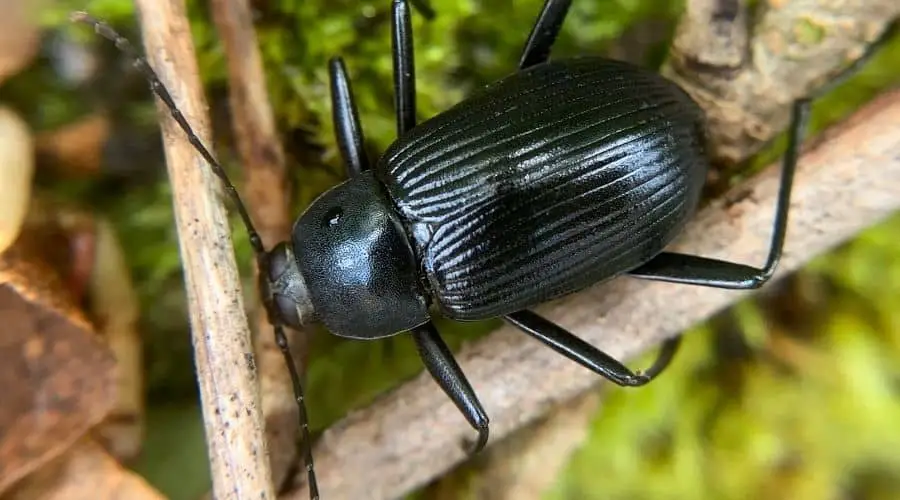Darkling beetles have wings, but not the same way most other winged creatures have them. The wings on these species, known as elytra, are fused over the tops of their bodies, making flight nearly impossible.
However, at least one unique Darkling species break this rule and have separate elytra with alae wings beneath. Can Darkling beetles fly?
Darkling beetles don’t fly due to their fused elytra, which don’t separate or flap and prevent functional wings from forming underneath. There are over 20,000 species of Darkling beetles and a majority of them don’t fly. Only a couple of species of Darkling beetles can fly. Fortunately, Darkling beetles have a nocturnal lifestyle and diverse diet, they don’t need flight to thrive.
Table of Contents
Does Darkling Beetle Fly
Asking if a Darkling beetle flies is a more complex question than you might expect. With tens of thousands of species of Darklings, they don’t all have the same traits, so some fly and others do not.
What Darklings have in common is a nocturnal lifestyle, dark-colored exterior, genetics from the same line of beetles with a common ancestor, and a similar lifecycle.
The mealworm larvae grow into Darkling beetles with functional alae wings under non-fused elytra wing covers. These unusual and notable Darkling beetles fly, though only when needed, which isn’t often.
However, through the first three stages of their lives, these beetles don’t fly or even look like beetles.
All Darkling begin as eggs, which clearly don’t fly. Upon hatching, they become worm-like larvae, eating and growing for the next 4 to 19 days.
As pupa, the Darklings don’t move at all but rather conserve all their energy for growth into their final beetle form. Of the four life stages, Darkling beetles go through; only the final stage has the possibility of growing wings to fly.
Do Darkling Beetles Have Wings To Fly
Darkling beetles can have wings to fly, but only the mealworm variety or Tenebrio Molitor.
When you raise these particular Darklings, it is easy to see how their many cousins lost the power of flight. If mealworm beetles take flight, it is awkward and clumsy flying.
Numerous sources insist these beetles cannot fly. However, Bromely.gov in the UK points out, “Mealworm beetles (Tenebrio Molitor) are widespread throughout Britain. The adult beetles fly and are attracted to light… They are usually associated with birds’ nests or long-standing food residues and other debris in stores and cellars etc.”
Captive mealworm Darklings typically do not fly. Because they are bred as feeders and usually have all they could ever want to eat, there is no reason to waste all that energy trying to flap around just to come back to where the food is located.
How Do Darkling Beetles Move Without Wings
Beetles have no trouble moving around without wings. As larva, they move like worms, pushing the forward segments of their body ahead, then pulling the back end up to meet it. Once they become adults, beetles have six legs.
Beetles walk in an unusual gait. According to Parks Canada Beetle Anatomy, “When beetles walk, a foreleg and hind leg on one side and a middle leg on the other are always touching the ground. This creates a “tripod” on which the beetle balances, and on the next step the beetle alternates to the other three legs to form a new tripod.”
Not only can darkling beetles walk on their legs, but they can use them to climb as well. Beetles and numerous other insects have claws, though not like a cat.
At the bottom of their legs, Darklings and other beetles have a hooked claw on the last tarsal segment for holding and climbing.
Additionally, the claws and legs have thousands of microscopic hairs on them, which increase the surface area and give them superb traction.
For some species, the hairs also secrete a sticky oil to help them cling to smooth surfaces.
How Do Darkling Beetles Flee Danger If They Can’t Fly
Darkling beetle predators in nature tend to be quick and decisive, like a bird swooping down from the sky or an unexpected frog tongue.
In these cases, there’s little chance of escape, and beetles typically can’t flee fast enough. When they can see danger coming, beetles may skitter away quickly and seek cover or burrow down into soft soil.
Walking away is often enough to escape from an unpleasant and potentially dangerous situation. Animals and insects rarely fight unless threatened, hurt or hungry.
For many, the gesture of standing your ground or trying to look bigger is all it takes to end a confrontation quickly and nonviolently.
Not all Darkling beetles flee from danger. Some beetles, including numerous Darklings, turn around and put their posterior up in the air if threatened.
This behavior is a warning that they are prepared to emit a chemical, and often the posture alone is enough defense.
Most animals recognize this the same as they would recognize a skunk backing up toward them, even if they have no previous experience with this situation.
Many Darkling beetles have a chemical compound they can spray out in a pinch. The most famous chemical defender in the Darkling family is the stink beetle.
As Orkin points out, “Beetles in the genus Eleodes are known by the common names stink beetles, darkling beetles, or clown beetles. The common name clown beetle comes from the beetle’s habit of standing on its head and assuming a defensive posture when disturbed. Stink beetles are not stink bugs and are different…”
However, it also points out that only around a third of these beetles can actually emit a stinky substance. The rest are mimics.
Helpful Tips To Know If A Darkling Beetle Can Fly
The mealworm, Darkling beetles cannot fly unless you’re talking about the Tenebrio Molitor. Their fused wings, known as elytra, make a better protective barrier than a flight surface.
Here are some other helpful tips to know if a Darkling Beetle can fly.
- The functional wings are called alae on flying beetle species, and they are only one of two wing sets. Flying beetles also have elytra, but theirs are not fused. Instead, beetles that can fly have two elytra that they close over their wings or lift out of the way depending on what they are doing at the time.
- Most species of beetles worldwide can fly, though their flight is ponderous and often clumsy compared to more agile and skilled fliers. Even many water beetles fly well enough to get around. It’s even more incredible when you realize there are over 20,000 species of flightless Darkling beetles.
- There are over here hundred fifty thousand known Coleoptera (beetle) species on earth, and over thirty thousand of these live within the US. However, only around 1,300 of those beetle species are Darklings.
- Darkling beetles tend to live in tropical and temperate regions, which makes sense—as nocturnal insects, living too near the poles would affect their circadian rhythm and throw off their breeding patterns.
Final Thoughts
Although more than ninety-nine percent of all Darkling beetles cannot fly, they are hardy survivors. Having fused elytra is advantageous if you spend most of your time near the ground.
Plus, Darklings don’t need to fly to reach food sources and escape predation. Since these diverse species are omnivorous scavengers and opportunists, and they seldom go without a meal.
Darkling beetles eat almost anything organic, and the world is covered in organic materials, so flying around to find more is unnecessary.

